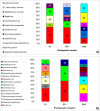Microbial communities affecting albumen photography heritage: a methodological survey
- PMID: 26864429
- PMCID: PMC4749957
- DOI: 10.1038/srep20810
Microbial communities affecting albumen photography heritage: a methodological survey
Abstract
This study is one of the few investigations which analyze albumen prints, perhaps the most important photographic heritage of the late 19(th) and early 20(th) centuries. The chemical composition of photographic samples was assessed using Fourier-transform infrared spectroscopy and X-ray fluorescence. These two non-invasive techniques revealed the complex nature of albumen prints, which are composed of a mixture of proteins, cellulose and salts. Microbial sampling was performed using cellulose nitrate membranes which also permitted the trapped microflora to be observed with a scanning electron microscope. Microbial analysis was performed using the combination of culture-dependent (cultivation in different media, including one 3% NaCl) and culture-independent (bacterial and fungal cloning and sequencing) approaches. The isolated microorganisms were screened for their lipolytic, proteolytic, cellulolytic, catalase and peroxidase activities. The combination of the culture-dependent and -independent techniques together with enzymatic assays revealed a substantial microbial diversity with several deteriogen microorganisms from the genera Bacillus, Kocuria, Streptomyces and Geobacillus and the fungal strains Acrostalagmus luteoalbus, Bjerkandera adusta, Pleurotus pulmonarius and Trichothecium roseum.
Figures






Similar articles
-
Microbial Life and Death in a Foxing Stain: a Suggested Mechanism of Photographic Prints Defacement.Microb Ecol. 2017 May;73(4):815-826. doi: 10.1007/s00248-016-0913-7. Epub 2016 Dec 15. Microb Ecol. 2017. PMID: 27975134
-
Disclosing a crypt: microbial diversity and degradation activity of the microflora isolated from funeral clothes of Cardinal Peter Pázmány.Microbiol Res. 2013 Jun 12;168(5):289-99. doi: 10.1016/j.micres.2012.12.001. Epub 2013 Jan 8. Microbiol Res. 2013. PMID: 23305771
-
Investigation of microbial community isolated from indoor artworks and air environment: identification, biodegradative abilities, and DNA typing.Can J Microbiol. 2009 Mar;55(3):277-87. doi: 10.1139/w08-136. Can J Microbiol. 2009. PMID: 19370071
-
[Methods for the study of microbial communities in fermented foods].Rev Latinoam Microbiol. 2003 Jan-Jun;45(1-2):30-40. Rev Latinoam Microbiol. 2003. PMID: 17061519 Review. Spanish.
-
Back to the past: "find the guilty bug-microorganisms involved in the biodeterioration of archeological and historical artifacts".Appl Microbiol Biotechnol. 2018 Aug;102(15):6393-6407. doi: 10.1007/s00253-018-9113-3. Epub 2018 Jun 4. Appl Microbiol Biotechnol. 2018. PMID: 29869070 Review.
Cited by
-
Microbial Contamination of Photographic and Cinematographic Materials in Archival Funds in the Czech Republic.Microorganisms. 2022 Jan 12;10(1):155. doi: 10.3390/microorganisms10010155. Microorganisms. 2022. PMID: 35056604 Free PMC article.
-
Touching the (almost) untouchable: a minimally invasive workflow for microbiological and biomolecular analyses of cultural heritage objects.Front Microbiol. 2023 Aug 3;14:1197837. doi: 10.3389/fmicb.2023.1197837. eCollection 2023. Front Microbiol. 2023. PMID: 37601377 Free PMC article.
-
Microbial communities responsible for the degradation of poly(lactic acid)/poly(3-hydroxybutyrate) blend mulches in soil burial respirometric tests.World J Microbiol Biotechnol. 2018 Jun 22;34(7):101. doi: 10.1007/s11274-018-2483-y. World J Microbiol Biotechnol. 2018. PMID: 29934788
-
Microbial diversity in biodeteriorated Greek historical documents dating back to the 19th and 20th century: A case study.Microbiologyopen. 2018 Oct;7(5):e00596. doi: 10.1002/mbo3.596. Epub 2018 Feb 27. Microbiologyopen. 2018. PMID: 29484839 Free PMC article.
-
Fungi with history: Unveiling the mycobiota of historic documents of Costa Rica.PLoS One. 2023 Jan 18;18(1):e0279914. doi: 10.1371/journal.pone.0279914. eCollection 2023. PLoS One. 2023. PMID: 36652424 Free PMC article.
References
-
- Marien M. W. Photography: A cultural history. Laurence King Publishing (2006).
-
- Reilly J. M. & McCabe C. Care and identification of 19th century photographic prints. Eastman Kodak Company (1986).
-
- Cappitelli F. & Sorlini C. From papyrus to compact disc: the microbial deterioration of documentary heritage. Crit. Rev. Microbiol. 31, 1–10 (2005). - PubMed
-
- Sterflinger K. & Pinzari F. The revenge of time: fungal deterioration of cultural heritage with particular reference to books, paper and parchment. Environ. Microbiol. 14, 559–566 (2012). - PubMed
Publication types
MeSH terms
Substances
LinkOut - more resources
Full Text Sources
Other Literature Sources
Medical
Molecular Biology Databases

